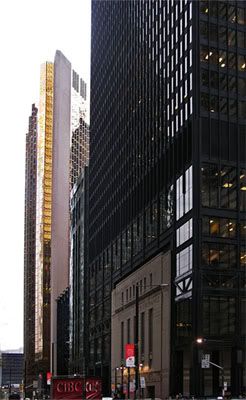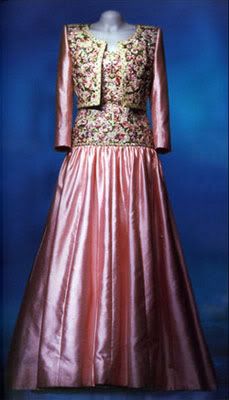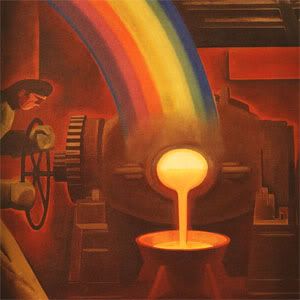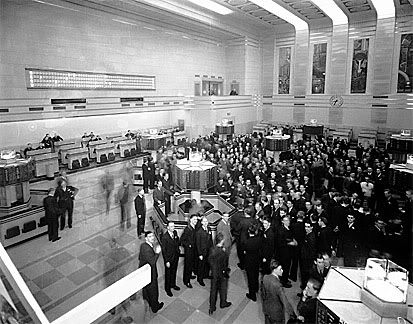 |
The streamline moderne, art deco,
and stripped classicism styles of the Design Exchange
building surrounded by the modernist
Mies van der Rohe Toronto Dominion Centre.
In the background is the gold-covered Royal Bank Plaza.
I was at the Design Exchange building (formerly the Toronto Stock Exchange building) yesterday because I remembered that the building was incorporated into Mies van der Rohe's modernist Toronto Dominion Centre, which I've blogged about here. Once inside, I realized that this was where Princess Diana's dresses were assembled for view before being auctioned off (I had seen the various television promotions that the dresses were to be displayed in Toronto this spring, wrapping up a world tour). The dresses were bought over the years by an American investor Maureen Rorech Dunkel, who set up The People's Princess Charitable Foundation.
I wondered why Dunkel was selling these heirlooms, and a Google search shows that she filed for bankruptcy in 2010. Here's some background:
Dunkel's motivation for putting the gowns up for auction isn't known but she filed for bankruptcy protection in January 2010 after HRH Ventures LLC sued her and the People's Princess Charitable Foundation Inc. claiming they defaulted on $1.5 million in loans that were secured by the gowns. HRH Ventures asked a court for five of the dresses, alleging that Dunkel and her foundation weren't able to "adequately care for these irreplaceable dresses." Dunkel countered that she had agreed to repay the loans no sooner than 2012. The lawsuit was stayed by the bankruptcy filing.It is apt that these dresses, which are estimated to fetch about 3 million dollars, should be exhibited in a design hall whose building was once the center of speculations on money.
Waddington's auctioneers are displaying the dresses at the Design Exchange until the auction on June 23.
 |
A long evening dress of lilac wild silk,
with an embroidered bolero.
From Waddington's website:
A lilac silk dress with a bodice embroidered overall with pink and white flowers, green & star shaped sequins, gold glass beads and gold braid in Mughal motifs. The long sleeved bolero jacket embroidered overall en suite with the dress.
Designed for Diana’s State Tour of India in 1992...Embroidered in the Mughal fashion, it is a tapestry of flowers, sequins and gold, giving the appearance of encrusted jewels.
‘My Decade With Diana: The Perpetual Power of the People’s Princess’, G.A. McNulty, 2007, pg 46
 |
in the Design Exchange
Here's what the Design Exchange catalog says about the building:
Designed by architects George and Moorhouse with associate S.H. Maw and completed in 1937, the Toronto Stock Exchange building combined streamlined moderne, art deco and stripped classicism styles. Although it is commonly labeled an art deco building, the dominant style is streamlined moderne...Its design was revered as an architectural and technological marvel, a "masterful expression of its time, place and function" with "the most up-to-date trading floor in the world."More information is available at the Design Exchange website.
The Exchange building was a major construction project for its day. The Depression had hit Toronto's building industry hard, causing public and private sector spending on building construction to plummet. The $750,000 TSE building represented a significant portion of the city's total construction activity in 1936-37.
The TSE building was designated a heritage property in 1978 because f its "architectural value and historic interest." in 1983, the Exchange moved to its current headquarters at the corner of King and York. The original building has remained wholly intact and parts were fully restored by the developer. The specific heritage components surviving today are the building's exterior, the facade and frieze, windows on all levels, two sets of stainless steel doors, the Vale Inco Grand Staircase and detailing, the trading floor, eight murals by Charles Comfort, and the only surviving post from the trading floor.
In 1994, Kuwabara Payne McKenna Blumberg Architects (KPMB) incorporated the historic Trading Floor and the TSE structure into the unique Toronto-Dominion Centre complex, creating a blend of old and new spaces to be used for the purposes of the Design Exchange.
Below is a section of the frieze above the building's entrance, also by Charles Comfort, and a funny anecdote by Artistic Toronto:
 |
In 1969 the Toronto Star headlined this 1937 limestone relief of the Stock Exchange building’s 22.5 metre-long frieze “a bay street joke preserved in granite.”
Painter, Charles Comfort who designed the engraving denied any forethought to the seeming parody, in which a well suited stockbroker is depicted lingering his hand over the pocket of an oblivious common labourer, as if greedily taking what does not belong to him.
At the time this little discovery stirred quite a fuss within the city’s financial district. The relief was also implemented during the Great Depression, when a lot of society shared overwhelming feelings of economic betrayal.
To this day, there is debate over just how suggestive the artist wanted to be, or if it was all just blown out of proportion years later.
 |
City of Toronto Archives, Series 1057, Item 461.